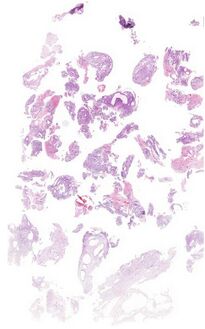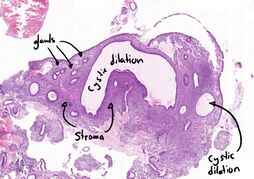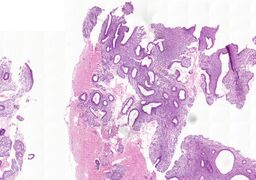17. Glandular cystic hyperplasia of the endometrium

Staining: HE Organ: Uterine tissue acquired by curettage
Description: The uterine tissue morphology is mostly lost during the curettage. We can only see fragments of the endometrium. Normal uterine glands can be seen, however some of them have a (sometimes extremely) enlarged lumen. Normal uterine stroma can be seen. The total number of glands are increased compared to physiological.
Diagnosis: Endometrial hyperplasia, simple type without atypia
Causes: Any condition characterised by increased oestrogen, including anovulatory cycles, postmenopausal oestrogen therapy, polycystic ovary syndrome, and obesity
Theory: Anovulatory cycles are “menstrual” cycles that occur without ovulation. It can occur now and then in pubertal and menopausal women. In the menstrual cycle, the proliferative phase is stimulated by oestrogen while the secretory phase is stimulated by progesterone. If, for some reason, the proliferative phase is prolonged, the endometrium will be exposed to oestrogen for a longer time, allowing it to turn more hyperplastic than normal.

After menopause the low level of oestrogen in the blood causes the patients to experience a variety of symptoms. This can be treated with postmenopausal hormone therapy however this may increase the risk for endometrial hyperplasia. Four subtypes of endometrial hyperplasia exist. They can all lead to cancer, but different types have different risks. They are, in order from lowest to highest risk for developing cancer: Simple hyperplasia without atypia 1%, simple hyperplasia with atypia (~5%), complex hyperplasia without atypia (~20%), complex hyperplasia with atypia 40%. Patients with a diagnosis of complex atypical hyperplasia should always consider a hysterectomy.

We don’t have to know how to distinguish the different types or what atypia means in this context. The percentages in brackets are not to be known.
Three things point to that there is hyperplasia in this endometrial sample. The number of glands is increased compared to the normal, there is uterine stroma present, and we can see cystic dilation in some of the glands. Cystic dilation means that some glands have a large lumen. If there was no stroma present it would indicate cancer. Curettage is a method of scraping tissues using a curette.
